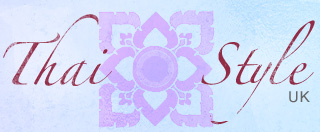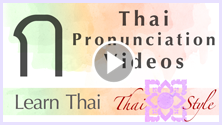What is Transliteration?
Karaoke Language
Learning Materials > Thai Teachers > Start Here
About: To transliterate is to write or print (a letter or word) using the closest corresponding letters of a different alphabet or language. For example, writing Thai words using the English alphabet.
Transliteration is the practice of converting a text from one script into another. In Thai, It’s called ทับศัพท์ : Túb~Sùb or ทับเสียง : Túb~Sĕarng but is commonly called as ภาษาคาราโอเกะ : Paa-săa Kaa-raa-o-ge’ = Karaoke language. (Vocab. : ทับ : Túb = place on top of, ศัพท์ : Sùb = vocabulary, เสียง : Sĕarng = sound, คาราโอเกะ : Kaa-raa-o-ge’ = karaoke)
There are many different forms of transliteration and different Thai language books use different methods. Some use standard phonetic symbols, some use the English alphabet.
There is no standard or best method of transliteration as no form can compare to the Thai alphabet exactly
At Thai Style we use the English alphabet for our transliterations. This is because it is easier for English learners to remember new Thai words written in English rather than learning weird phonetic symbols you may have never seen before. After all, you already speak English and want to learn Thai, not another writing system that you won’t use again after you learn Thai script.
As a beginner, when you read Thai words that are written with the English alphabet (transliterations) your pronunciation may be different depending on how you determine the English letters sound when speaking. Pronunciation can change with different dialects and accents, for example, people from London, Glasgow, Madrid and Berlin will pronounce the same written word differently. This is the reason why you should learn to speak Thai correctly with a native Thai speaker and not rely on learning from written text alone.
Example Transliteration:
ดี has 2 letters or nucleus/base sounds which are ด and ี .
We transliterate the letter or nucleus/base sound ด using the English letter D and the letter or nucleus/base sound ี using the English letters ee.
ดี = Dee
There are some sounds in Thai we do not make in English, so how do we write these sounds using the English alphabet? We can try to use English letters to compare to Thai sounds, however, they aren’t always perfect. Sometimes, you can’t find any English letters to make a perfect Thai sound. This is another reason you should learn to speak Thai with a native Thai speaker as they can help to correct your pronunciation.
Before you start learning to pronounce Thai words and make conversation in Thai, it is important for you to understand what the alphabet is, the differences between the English and Thai alphabet and how to pronounce the Thai alphabet.
During our Speak Thai Course you will learn to understand the Thai word system to help you pronounce Thai words using the English alphabet. This is not only essential to be able to speak Thai correctly but if you choose to continue onto our next courses it will make learning the Thai alphabet, reading and writing Thai, a much easier process.
A great resource to learn more about Transliterations : www.slice-of-thai.com/pronunciation-guides
What are Phonetic Transcriptions used in some other Thai books?
As mentioned above, some other Thai language books use different methods, some are called ‘Transcriptions’ or ‘Romanisation’.
Transcriptions are a form in which a speech sound or a foreign character is represented.
Phonetic transcription focuses on phonetic and phonological properties of spoken language. Systems for phonetic transcription thus furnish rules for mapping individual sounds or phonemes to written symbols. Phonetic transcription operates with specially defined character sets, usually the International Phonetic Alphabet (IPA).
What is the International Phonetic Alphabet (IPA)?
The International Phonetic Alphabet (IPA) is an alphabetic system of phonetic notation based primarily on the Latin alphabet. It was devised by the International Phonetic Association as a standardized representation of the sounds of oral language. The IPA is used by foreign language students and teachers, linguists, Speech-Language Pathologists, singers, actors, lexicographers, constructed language creators (conlangers), and translators who study a language in-depth.
Read more about IPA : Wikipedia
Why Thai Style does not use the International Phonetic Alphabet (IPA) in our courses?
We have chosen not to use the IPA system because we want to provide a solution for every type of learner with any education background. It is far easier for English speakers to remember Thai words in written English rather than learning a new phonetic system and weird phonetic symbols you may have never seen before.
Most of our learners just want to speak Thai, they do not want to learn another alphabet when English will do the job. Phonetic transcriptions are another field of study suitable for higher education learners, like students studying a language in-depth in a university.


